Eco-Friendly Dye-Sensitized Solar Cells Based on Water-Electrolytes and Chlorophyll
Abstract
1. Introduction
2. Materials and Methods
2.1. Materials
2.2. Fabrication of DSSCs with the Organic Synthetic Dye
2.3. Fabrication of Chlorophyll Based DSSCs
2.4. Photovoltaic Measurement
3. Results and Discussion
4. Conclusions
Author Contributions
Funding
Institutional Review Board Statement
Informed Consent Statement
Data Availability Statement
Conflicts of Interest
References
- Iftikhar, H.; Sonai, G.G.; Hashmi, S.G.; Nogueira, A.F.; Lund, P.D. Progress on Electrolytes Development in Dye-Sensitized Solar Cells. Materials 2019, 12, 1998. [Google Scholar] [CrossRef] [PubMed]
- Bella, F.; Gerbaldi, C.; Barolo, C.; Grätzel, M. Aqueous dye-sensitized solar cells. Chem. Soc. Rev. 2015, 44, 3431–3473. [Google Scholar] [CrossRef]
- Green, M.A.; Dunlop, E.D.; Hohl-Ebinger, J.; Yoshita, M.; Kopidakis, N.; Ho-Baillie, A.W. Solar cell efficiency tables (Version 55). Prog. Photovolt. Res. Appl. 2019, 28, 3–15. [Google Scholar] [CrossRef]
- NREL, N. Research Cell Efficiency Records. Available online: https://www.nrel.gov/pv/cell-efficiency.html (accessed on 1 April 2021).
- Yoshikawa, K.; Kawasaki, H.; Yoshida, W.; Irie, T.; Konishi, K.; Nakano, K.; Uto, T.; Adachi, D.; Kanematsu, M.; Uzu, H.; et al. Silicon heterojunction solar cell with interdigitated back contacts for a photoconversion efficiency over 26%. Nat. Energy 2017, 2, 1–8. [Google Scholar] [CrossRef]
- Kakiage, K.; Aoyama, Y.; Yano, T.; Oya, K.; Fujisawa, J.-I.; Hanaya, M. Highly-efficient dye-sensitized solar cells with collaborative sensitization by silyl-anchor and carboxy-anchor dyes. Chem. Commun. 2015, 51, 15894–15897. [Google Scholar] [CrossRef]
- Nemala, S.S.; Kartikay, P.; Agrawal, R.K.; Bhargava, P.; Mallick, S.; Bohm, S. Few layers graphene based conductive composite inks for Pt free stainless steel counter electrodes for DSSC. Sol. Energy 2018, 169, 67–74. [Google Scholar] [CrossRef]
- Ju, M.J.; Jeon, I.-Y.; Kim, H.M.; Choi, J.I.; Jung, S.-M.; Seo, J.-M.; Choi, I.T.; Kang, S.H.; Kim, H.S.; Noh, M.J.; et al. Edge-selenated graphene nanoplatelets as durable metal-free catalysts for iodine reduction reaction in dye-sensitized solar cells. Sci. Adv. 2016, 2, e1501459. [Google Scholar] [CrossRef]
- Cao, Y.; Liu, Y.; Zakeeruddin, S.M.; Hagfeldt, A.; Grätzel, M. Direct Contact of Selective Charge Extraction Layers Enables High-Efficiency Molecular Photovoltaics. Joule 2018, 2, 1108–1117. [Google Scholar] [CrossRef]
- Zhang, H.; Qiu, L.; Xu, D.; Zhang, W.; Yan, F. Performance enhancement for water based dye-sensitized solar cells via addition of ionic surfactants. J. Mater. Chem. A 2013, 2, 2221–2226. [Google Scholar] [CrossRef]
- Galliano, S.; Bella, F.; Bonomo, M.; Viscardi, G.; Gerbaldi, C.; Boschloo, G.; Barolo, C. Hydrogel Electrolytes Based on Xanthan Gum: Green Route Towards Stable Dye-Sensitized Solar Cells. Nanomaterials 2020, 10, 1585. [Google Scholar] [CrossRef]
- Law, C.; Pathirana, S.C.; Li, X.; Anderson, A.Y.; Barnes, P.R.F.; Listorti, A.; Ghaddar, T.H.; O′regan, B.C. Water-Based Electrolytes for Dye-Sensitized Solar Cells. Adv. Mater. 2010, 22, 4505–4509. [Google Scholar] [CrossRef]
- Syafinar, R.; Gomesh, N.; Irwanto, M.; Fareq, M.; Irwan, Y. Chlorophyll Pigments as Nature Based Dye for Dye-Sensitized Solar Cell (DSSC). Energy Procedia 2015, 79, 896–902. [Google Scholar] [CrossRef]
- Hassan, H.C.; Abidin, Z.H.Z.; Chowdhury, F.I.; Arof, A.K. A High Efficiency Chlorophyll Sensitized Solar Cell with Quasi Solid PVA Based Electrolyte. Int. J. Photoenergy 2016, 2016, 1–9. [Google Scholar] [CrossRef]
- Yang, R.-Y.; Chen, H.-Y.; Lai, F.-D. Performance Degradation of Dye-Sensitized Solar Cells Induced by Electrolytes. Adv. Mater. Sci. Eng. 2012, 2012, 1–4. [Google Scholar] [CrossRef][Green Version]
- Agrell, H.G.; Lindgren, J.; Hagfeldt, A. Degradation mechanisms in a dye-sensitized solar cell studied by UV–VIS and IR spectroscopy. Sol. Energy 2003, 75, 169–180. [Google Scholar] [CrossRef]
- Hinsch, A.; Kroon, J.M.; Kern, R.; Uhlendorf, I.; Holzbock, J.; Meyer, A.; Ferber, J. Long-term stability of dye-sensitised solar cells. Prog. Photovolt. Res. Appl. 2001, 9, 425–438. [Google Scholar] [CrossRef]
- Koo, H.-J.; Velev, O.D. Regenerable Photovoltaic Devices with a Hydrogel-Embedded Microvascular Network. Sci. Rep. 2013, 3, srep02357. [Google Scholar] [CrossRef] [PubMed]
- Liu, Y.; Hagfeldt, A.; Xiao, X.-R.; Lindquist, S.-E. Investigation of influence of redox species on the interfacial energetics of a dye-sensitized nanoporous TiO2 solar cell. Sol. Energy Mater. Sol. Cells 1998, 55, 267–281. [Google Scholar] [CrossRef]
- Jung, Y.-S.; Yoo, B.; Lim, M.K.; Lee, S.Y.; Kim, K.-J. Effect of Triton X-100 in water-added electrolytes on the performance of dye-sensitized solar cells. Electrochim. ACTA 2009, 54, 6286–6291. [Google Scholar] [CrossRef]
- Han, J.-B.; Wang, X.; Wang, N.; Wei, Z.-H.; Yu, G.-P.; Zhou, Z.-G.; Wang, Q.-Q. Effect of plasma treatment on hydrophilic properties of TiO2 thin films. Surf. Coat. Technol. 2006, 200, 4876–4878. [Google Scholar] [CrossRef]
- Park, K.-H.; Dhayal, M. High efficiency solar cell based on dye sensitized plasma treated nano-structured TiO2 films. Electrochem. Commun. 2009, 11, 75–79. [Google Scholar] [CrossRef]
- Wang, W.; Chen, J.; Luo, J.; Zhang, Y.; Gao, L.; Liu, Y.; Sun, J. Effects of low pressure plasma treatments on DSSCs based on rutile TiO2 array photoanodes. Appl. Surf. Sci. 2015, 324, 143–151. [Google Scholar] [CrossRef]
- Kim, H.J.; Kim, J.; Hong, B. Effect of hydrogen plasma treatment on nano-structured TiO2 films for the enhanced performance of dye-sensitized solar cell. Appl. Surf. Sci. 2013, 274, 171–175. [Google Scholar] [CrossRef]
- Chang, H.; Yang, Y.-J.; Li, H.-C.; Hsu, C.-C.; Cheng, I.-C.; Chen, J.Z.; Hsu, J.C.-C. Preparation of nanoporous TiO2 films for DSSC application by a rapid atmospheric pressure plasma jet sintering process. J. Power Sources 2013, 234, 16–22. [Google Scholar] [CrossRef]
- Parvez, K.; Yoo, G.M.; Kim, J.H.; Ko, M.J.; Kim, S.R. Comparative study of plasma and ion-beam treatment to reduce the oxygen vacancies in TiO2 and recombination reactions in dye-sensitized solar cells. Chem. Phys. Lett. 2010, 495, 69–72. [Google Scholar] [CrossRef]
- Weerasinghe, J.; Sen, S.; Kumari, J.; Dissanayake, M.; Senadeera, G.; Thotawatthage, C.; Ekanayake, M.; Zhou, R.; Cullen, P.J.; Sonar, P.; et al. Efficiency enhancement of low-cost metal free dye sensitized solar cells via non-thermal atmospheric pressure plasma surface treatment. Sol. Energy 2021, 215, 367–374. [Google Scholar] [CrossRef]
- Arof, A.K.; Ping, T.L. Chlorophyll as Photosensitizer in Dye-Sensitized Solar Cells. In Chlorophyll; BoD–Books on Demand: Norderstedt, Germany, 2017; pp. 105–121. [Google Scholar] [CrossRef]
- Al-Alwani, M.A.; Mohamad, A.B.; Kadhum, A.A.H.; Ludin, N.A. Effect of solvents on the extraction of natural pigments and adsorption onto TiO2 for dye-sensitized solar cell applications. Spectrochim. ACTA Part. A Mol. Biomol. Spectrosc. 2015, 138, 130–137. [Google Scholar] [CrossRef] [PubMed]
- Kim, J.T.; Kim, S.H. Surface modification of TiO2 electrode by various over-layer coatings and O2 plasma treatment for dye sensitized solar cells. Sol. Energy Mater. Sol. Cells 2011, 95, 336–339. [Google Scholar] [CrossRef]
- Amao, Y.; Komori, T. Bio-photovoltaic conversion device using chlorine-e6 derived from chlorophyll from Spirulina adsorbed on a nanocrystalline TiO2 film electrode. Biosens. Bioelectron. 2004, 19, 843–847. [Google Scholar] [CrossRef] [PubMed]
- Lim, A.; Manaf, N.H.; Tennakoon, K.; Chandrakanthi, R.L.N.; Lim, L.B.L.; Bandara, J.M.R.S.; Ekanayake, P. Higher Performance of DSSC with Dyes from Cladophora sp. as Mixed Cosensitizer through Synergistic Effect. J. Biophys. 2015, 2015, 1–8. [Google Scholar] [CrossRef]
- Arifin, Z.; Soeparman, S.; Widhiyanuriyawan, D.; Sutanto, B.; Suyitno, S. Performance enhancement of dye-sensitized solar cells (DSSCs) using a natural sensitizer. International Conference on Engineering, Science and Nanotechnology 2016 (ICESNANO 2016). Int. J. Photoenergy 2017, 2704864. [Google Scholar] [CrossRef]
- Bohn, T.; Walczyk, T. Determination of chlorophyll in plant samples by liquid chromatography using zinc–phthalocyanine as an internal standard. J. Chromatogr. A 2004, 1024, 123–128. [Google Scholar] [CrossRef] [PubMed]
- Rahman, M.; Umar, A.A.; Taslim, R.; Salleh, M.M. Effect of organic dye, the concentration and dipping time of the organic dye N719 on the photovoltaic performance of dye-sensitized ZnO solar cell prepared by ammonia-assisted hydrolysis technique. Electrochim. ACTA 2013, 88, 639–643. [Google Scholar] [CrossRef]
- Chiba, Y.; Islam, A.; Watanabe, Y.; Komiya, R.; Koide, N.; Han, L. Dye-Sensitized Solar Cells with Conversion Efficiency of 11.1%. Jpn. J. Appl. Phys. 2006, 45, L638–L640. [Google Scholar] [CrossRef]
- Freitag, M.; Teuscher, J.; Saygili, Y.; Zhang, X.; Giordano, F.; Liska, P.; Hua, J.; Zakeeruddin, S.M.; Moser, J.-E.; Grätzel, M.; et al. Dye-sensitized solar cells for efficient power generation under ambient lighting. Nat. Photon. 2017, 11, 372–378. [Google Scholar] [CrossRef]
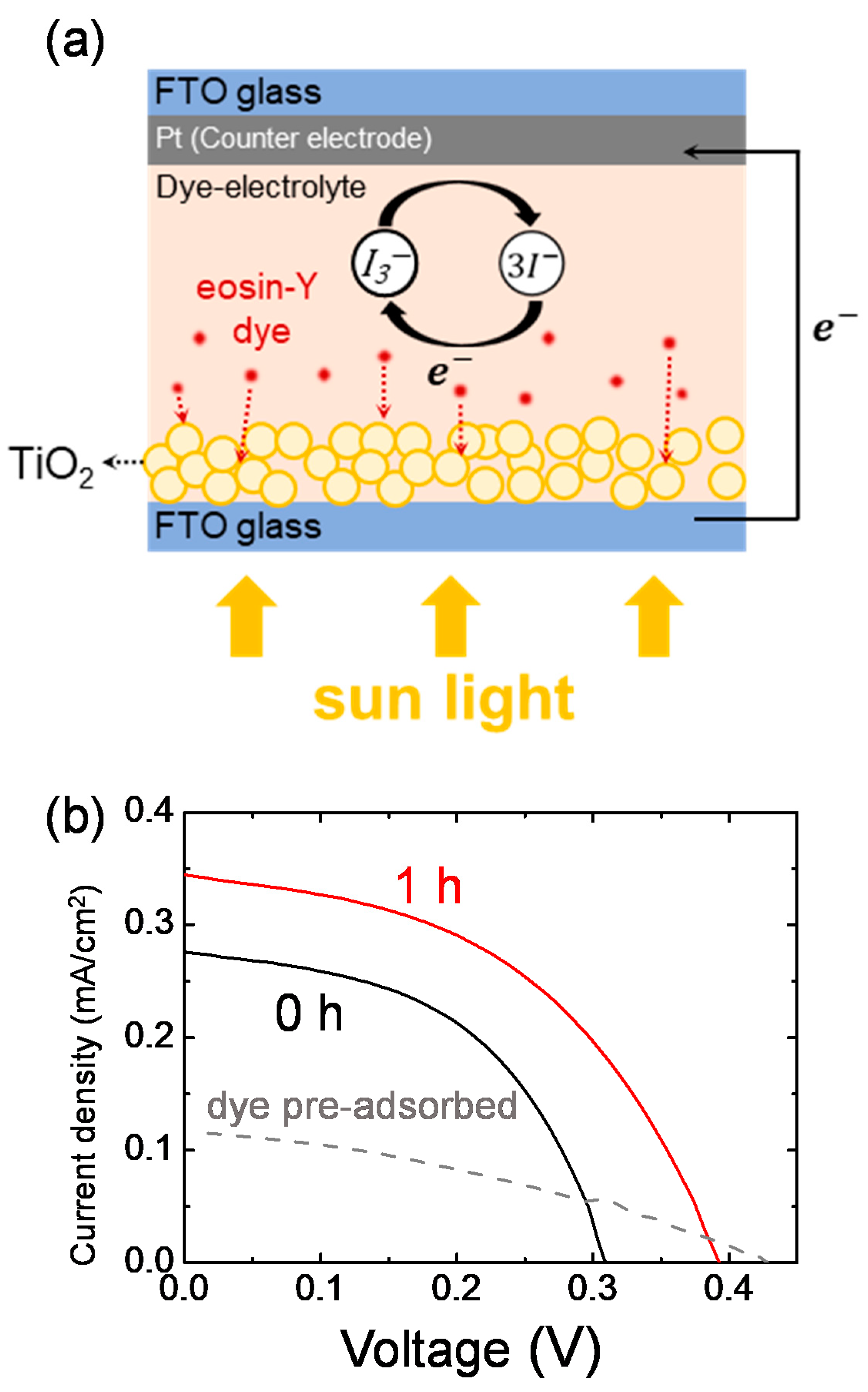
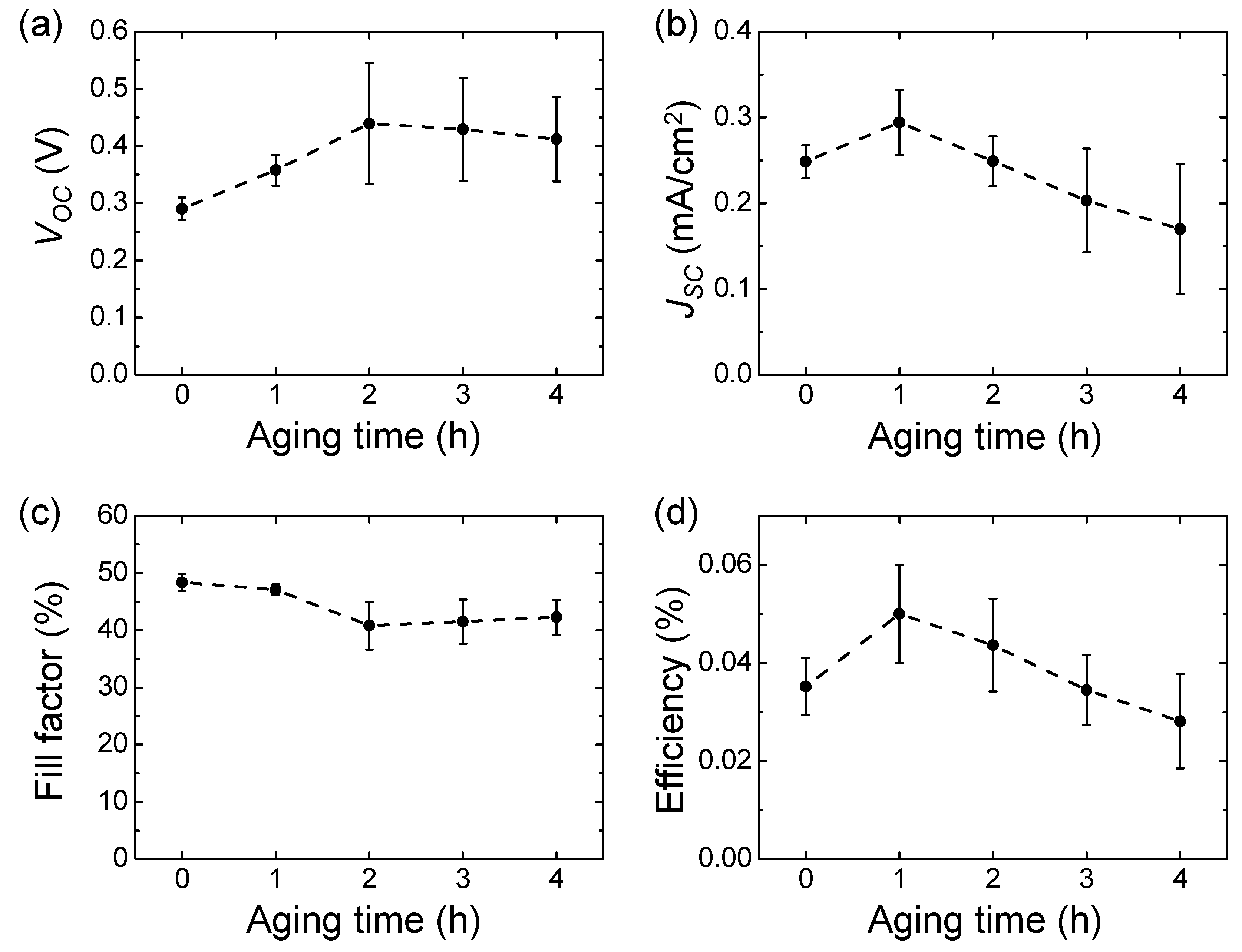
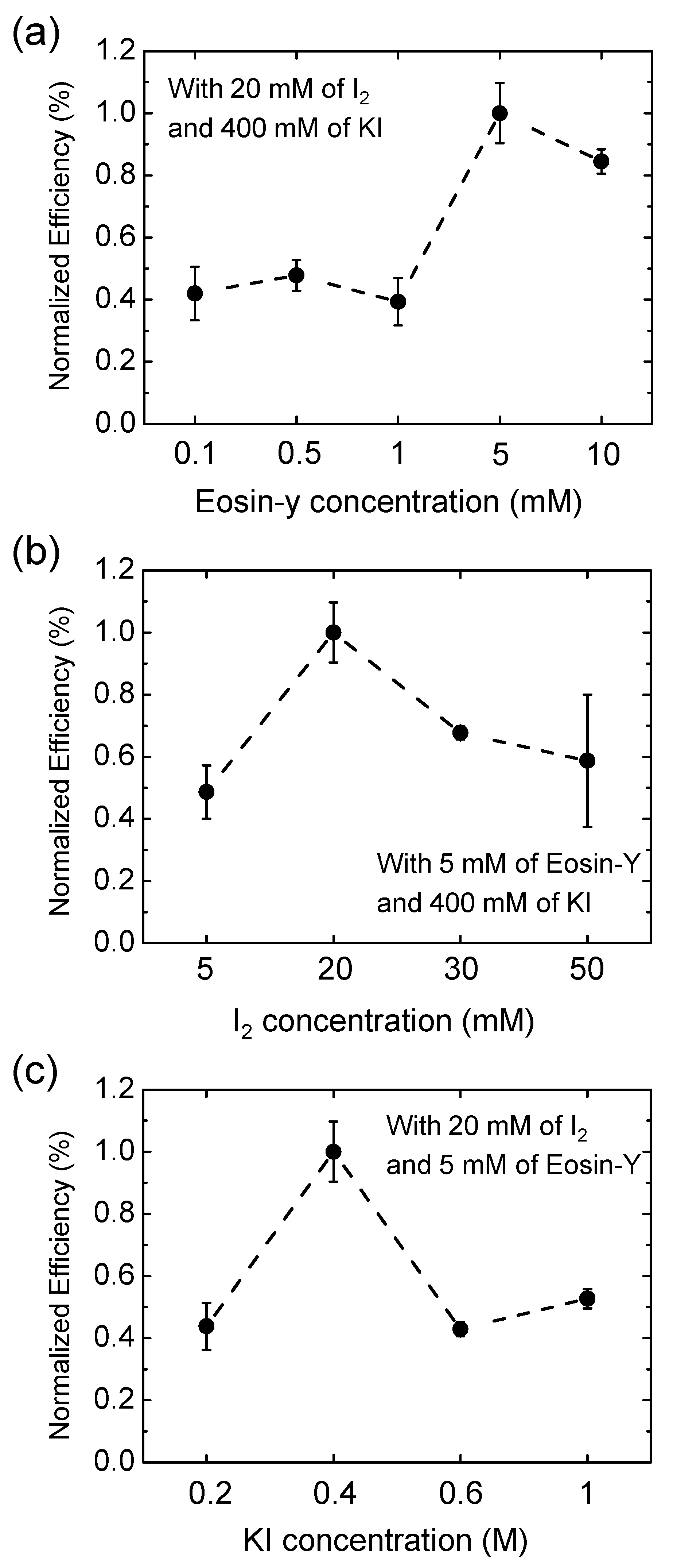
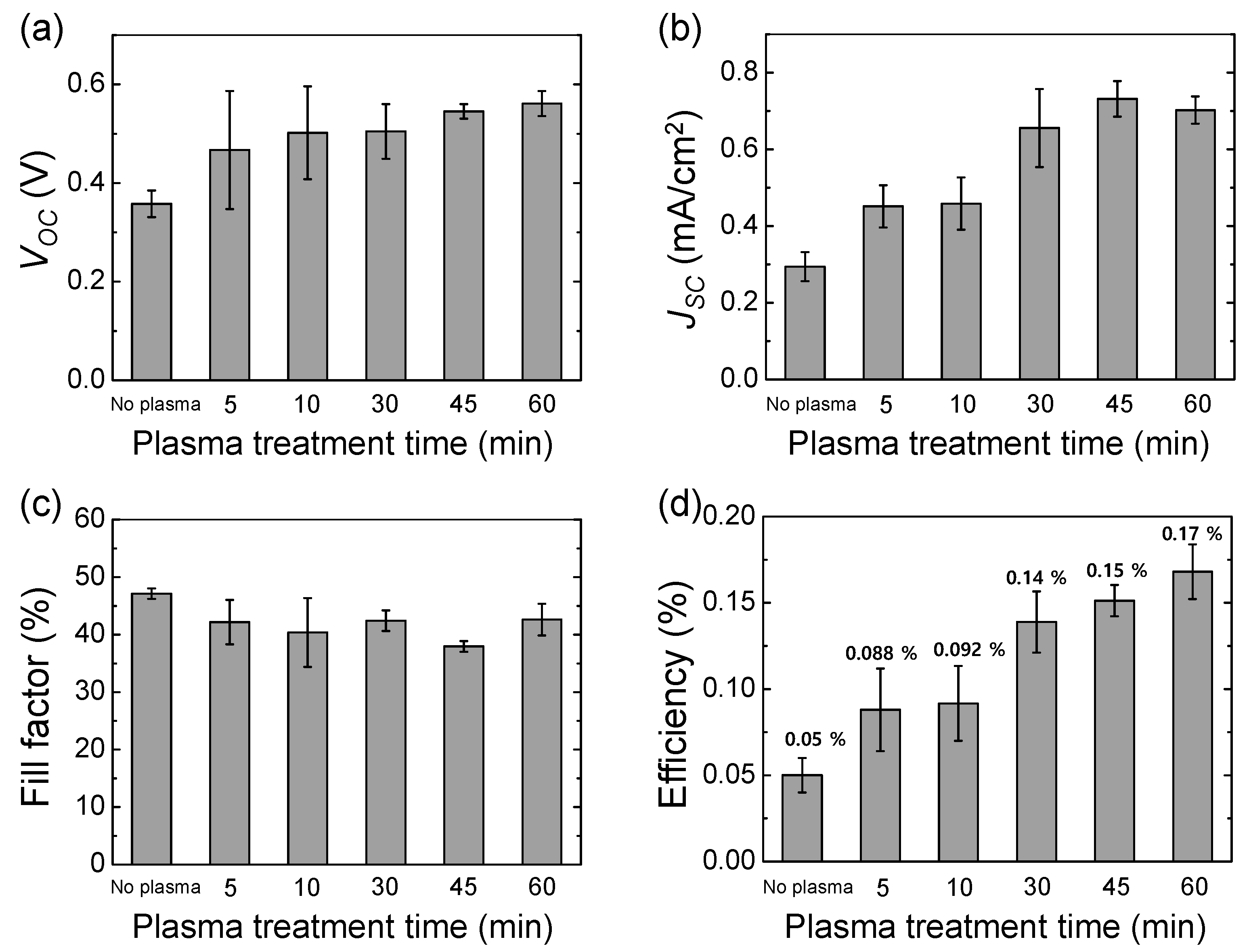
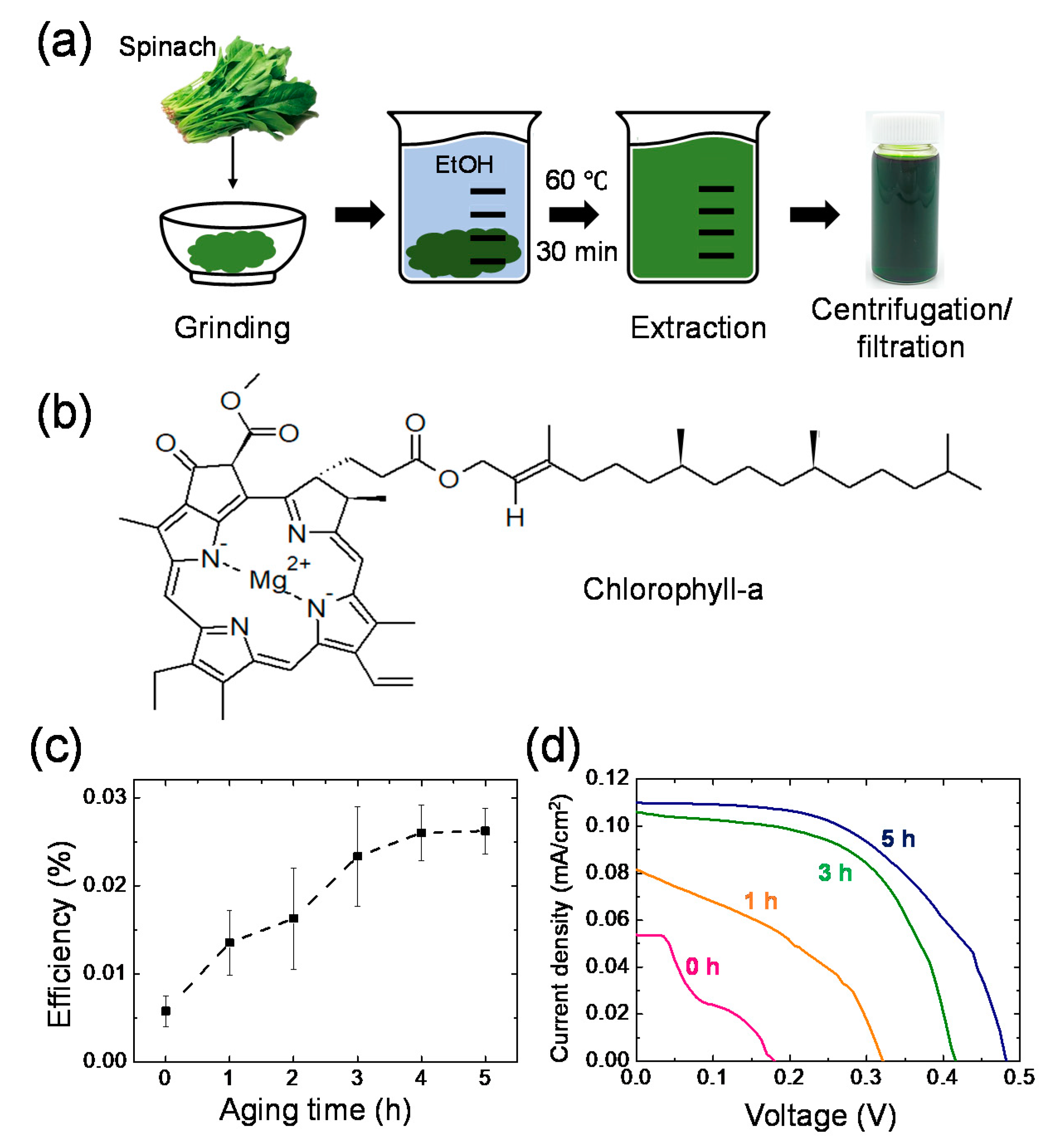

| State of Dye | Aging Time (h) | VOC (V) | JSC (mA/cm2) | Fill Factor (%) | Efficiency (%) |
|---|---|---|---|---|---|
| Dye in electrolyte (dye-electrolyte) | 0 | 0.31 | 0.28 | 50.3 | 0.044 |
| 1 | 0.39 | 0.35 | 47.1 | 0.064 | |
| Dye pre-adsorbed | - | 0.43 | 0.12 | 34.2 | 0.017 |
| Plasma Treatment | VOC (V) | JSC (mA/cm2) | Fill Factor (%) | Efficiency (%) |
|---|---|---|---|---|
| Without plasma | 0.35 | 0.29 | 47.1 | 0.05 |
| With plasma for 60 min | 0.56 | 0.70 | 42.6 | 0.17 |
| Plasma Treatment | VOC (V) | JSC (mA/cm2) | Fill Factor (%) | Efficiency (%) |
|---|---|---|---|---|
| Without plasma | 0.46 | 0.089 | 56.4 | 0.023 |
| With plasma for 60 min | 0.46 | 0.14 | 52.4 | 0.033 |
Publisher’s Note: MDPI stays neutral with regard to jurisdictional claims in published maps and institutional affiliations. |
© 2021 by the authors. Licensee MDPI, Basel, Switzerland. This article is an open access article distributed under the terms and conditions of the Creative Commons Attribution (CC BY) license (https://creativecommons.org/licenses/by/4.0/).
Share and Cite
Kim, J.-H.; Park, S.-Y.; Lim, D.-H.; Lim, S.-Y.; Choi, J.; Koo, H.-J. Eco-Friendly Dye-Sensitized Solar Cells Based on Water-Electrolytes and Chlorophyll. Materials 2021, 14, 2150. https://doi.org/10.3390/ma14092150
Kim J-H, Park S-Y, Lim D-H, Lim S-Y, Choi J, Koo H-J. Eco-Friendly Dye-Sensitized Solar Cells Based on Water-Electrolytes and Chlorophyll. Materials. 2021; 14(9):2150. https://doi.org/10.3390/ma14092150
Chicago/Turabian StyleKim, Ji-Hye, Sung-Yoon Park, Dong-Hyuk Lim, So-Young Lim, Jonghoon Choi, and Hyung-Jun Koo. 2021. "Eco-Friendly Dye-Sensitized Solar Cells Based on Water-Electrolytes and Chlorophyll" Materials 14, no. 9: 2150. https://doi.org/10.3390/ma14092150
APA StyleKim, J.-H., Park, S.-Y., Lim, D.-H., Lim, S.-Y., Choi, J., & Koo, H.-J. (2021). Eco-Friendly Dye-Sensitized Solar Cells Based on Water-Electrolytes and Chlorophyll. Materials, 14(9), 2150. https://doi.org/10.3390/ma14092150







